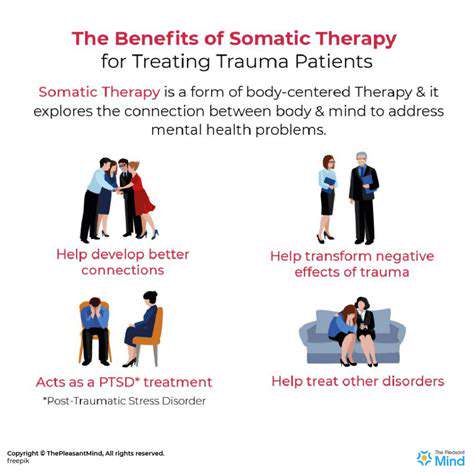Core Principles of Somatic Healing
Somatic therapy operates on the understanding that trauma affects the entire organism, not just the mind. This approach recognizes how traumatic experiences become encoded in bodily sensations, movement patterns, and autonomic responses. By working directly with these physical manifestations, somatic methods facilitate more complete trauma resolution than talk therapy alone can achieve.
The body remembers trauma through muscle tension, posture changes, and altered breathing patterns - all of which somatic therapy addresses. This embodied approach helps patients reclaim a sense of safety and agency within their own physical being.
Autonomic Nervous System Regulation
Somatic therapy specifically targets the autonomic nervous system's trauma responses. Many trauma survivors fluctuate between hyperarousal (anxiety, panic) and hypoarousal (numbness, dissociation). Therapists guide patients in recognizing these states and developing skills to restore balance through breathwork, grounding techniques, and mindful movement.
By gradually expanding the nervous system's window of tolerance, patients develop greater capacity to handle stress without becoming overwhelmed. This increased resilience directly translates to reduced headache frequency and intensity for many individuals.
Mind-Body Reintegration
Trauma often creates disconnection between thoughts, emotions, and physical sensations. Somatic therapy bridges these divides by helping patients safely reconnect with their bodily experience. Through guided exercises, patients learn to track sensations, identify areas of holding, and practice releasing accumulated tension.
This reintegration process fosters greater self-awareness and emotional regulation capacity. As patients become more attuned to their body's signals, they can intervene earlier when headache symptoms begin developing.
Establishing Safety Foundations
Effective somatic work requires carefully establishing physical and emotional safety first. Therapists create secure environments where patients can explore sensations at a manageable pace, always maintaining control over the process. This foundational safety allows deeper trauma processing to occur without retraumatization.
Patients learn concrete self-regulation tools to use during and between sessions. These might include orienting techniques, resourcing exercises, or simple movement sequences that help restore nervous system balance when distress arises.
Healing Relational Patterns
Interpersonal trauma often disrupts one's capacity for healthy connection. Somatic therapy addresses these relational wounds by helping patients recognize how trauma responses manifest in current relationships. Through the therapeutic relationship itself, patients practice new ways of engaging that honor both connection and personal boundaries.
This work helps reduce isolation while building skills for more satisfying relationships - an important factor in overall recovery and headache management.
Therapist's Specialized Role
Somatic therapists undergo specific training to safely guide embodied trauma processing. They attentively track clients' physiological responses, adjusting interventions to maintain optimal arousal levels. Their expertise helps prevent overwhelm while facilitating meaningful progress.
These professionals blend traditional therapeutic skills with specialized body awareness techniques. Their nuanced understanding of trauma's physical manifestations informs every aspect of treatment planning and implementation.
Somatic Therapy's Application for Trauma Headaches

Key Therapeutic Mechanisms
Somatic therapy addresses trauma headaches through multiple interconnected pathways. It directly impacts nervous system regulation, reducing the hypervigilance and tension that contribute to headache development. By resolving trapped survival energy from past trauma, it decreases the overall stress load on the body that can trigger headache episodes.
This approach recognizes that headache disorders often represent the body's attempt to manage unresolved trauma responses. Addressing these root causes provides more lasting relief than symptom management alone.
Nervous System Repatterning
Chronic headaches frequently reflect dysregulated nervous system functioning. Somatic techniques help recalibrate the autonomic nervous system's stress response patterns, making it less reactive to potential triggers. Patients learn to recognize early signs of dysregulation and implement corrective strategies before headaches escalate.
Trauma Resolution Process
Rather than focusing exclusively on traumatic memories, somatic therapy attends to their physical manifestations. Therapists guide patients in safely processing trauma-related sensations that may be contributing to headache patterns. This body-centered approach allows for gradual release of stored tension without retraumatization.
The work proceeds at a pace the patient's nervous system can tolerate, with frequent checks to ensure processing remains manageable. This careful titration distinguishes somatic therapy from more confrontational trauma treatments.
Enhanced Self-Regulation Skills
A central benefit of somatic therapy involves developing concrete self-regulation tools. Patients gain practical skills for modulating their nervous system states, providing greater control over headache onset and progression. These skills become resources they can employ in daily life when stress accumulates.
Over time, patients develop increased tolerance for discomfort and greater resilience against headache triggers. This expanded capacity often reduces both headache frequency and the anxiety surrounding potential episodes.
Addressing Emotional Components
Somatic therapy recognizes how emotional patterns intertwine with physical symptoms. By working with the body's expression of emotions, it helps resolve stuck emotional energy that may be contributing to headache disorders. This integrated approach leads to more comprehensive healing than treating either aspect alone.
Patients often discover how specific emotions correlate with headache onset, enabling more targeted intervention strategies. This emotional-physical mapping proves invaluable for long-term management.
Therapeutic Relationship Factors
The somatic therapy relationship itself provides a corrective emotional experience for many trauma survivors. Within this carefully held space, patients learn to tolerate discomfort while maintaining connection - a skill that generalizes to other relationships. The therapist's attuned presence helps regulate the patient's nervous system during challenging work.
This relational component distinguishes somatic therapy from purely technical interventions. The healing occurs both through specific techniques and within the therapeutic relationship dynamic itself.